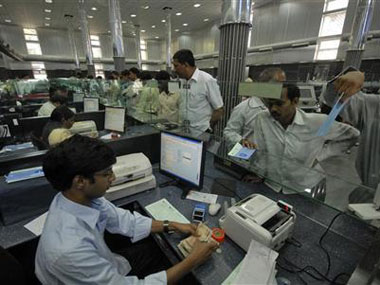Savers, watch out. Please latch on to whatever interest rates banks are offering on fixed deposits (FDs) now, for, in a few short weeks, we could see deposit rates falling even though inflation may stay high for a while.
Evidence of a near-future fall in rates is popping up from many sources.
First, since the economy is slowing down, credit demand is falling. According to the latest weekly data, the Reserve Bank of India (RBI) says that bank credit growth has fallen from 20.7 percent in mid-June 2011 to 17.8 percent in mid-June this year. When bank lending is falling, banks will seek to reduce deposit growth too.
Second, this may already be happening. According to Business Standard, banks are beginning to refuse bulk deposits from corporates. The newspaper says that some banks “are not accepting bulk deposits of more than Rs 10 crore from one customer” and the rates being offered are down by 0.5 percent on three-month deposits.
[caption id=“attachment_372097” align=“alignleft” width=“380”]  While it makes sense to latch on to fixed deposits when rates are going to fall, the only joker in the pack is inflation. Reuters[/caption]
Third, thanks to the RBI’s monetary easing - it raised banks’ access to cheap export finance last month instead of cutting rates - banks have almost stopped borrowing from the central bank through the repo window. A couple of months back, repo borrowings were in excess of Rs 1,00,000 crore a day. On 9 July, the outstandings on three-day repos were around Rs 11,530 crore. That’s almost nothing.
Four, thanks to easing global oil prices, banks’ biggest borrowers - the oil companies - are borrowing much less. This has automatically reduced bulk credit demand that was more or less like assured business for banks over the last three to four years.
Five, the RBI is meeting bankers today (9 July) in the run-up to the next monetary policy review on 31 July. Bankers are pitching for a rate cut to revive the economy. If the RBI agrees, deposit rates will also come down after 31 July.
Six, last month the State Bank - which sets the trend for loan and deposit rates - cut retail deposit rates for short-maturities going upto 240 days by 0.25 percent. Once the RBI policy is announced, one can expect cuts in deposits of longer maturities.
Seven, the government bond markets are also easing up - but very, very slightly. In the week to 6 July, yields on 10-year benchmark bonds, and also those of longer maturities, fell by 3-5 basis points (100 basis points make 1 percent). This kind of fall in yields is actually not a fall at all. In fact, market experts are surprised why our bonds markets are holding up when the European Central Bank and Bank of China cut rates. However, the explanation probably is that our bond markets are not sure what the RBI will do. The RBI has been more hawkish on inflation of late, and so the markets are doubtful on this score. Nevertheless, the slight easing shows where the trend is heading.
While it makes sense to latch on to fixed deposits when rates are going to fall, the only joker in the pack is inflation. If the government is unable to put a lid on it, your FDs will lose money when adjusted for inflation. But in a global recessionary scenario, the chances are even domestic inflation will fall.
A tip: Many government companies and quasi-government companies, have floated tax-free bonds paying 8-8.2 percent and these are listed on the stock markets. The National Highways Authority of India (NHAI) bond, for example (face value: Rs 1,000) is quoting at around Rs 1,077 on the National Stock Exchange. At the market price, the annual yield is over 7.5 percent. Since these are tax-free, investors in the top brackets might well make higher pre-tax returns on these bonds than in bank fixed deposits - with as little risk. Their liquidity is at least as good as the fixed deposits. (The other tax-free bonds include those by REC, PFC, Hudco, IRFC, etc)
A bonus: In a falling interest rate scenario, these tax-free bonds will rise in value as yields have to fall to equalise with currently available fixed deposit and bond prices. So you could end up making a small capital gain as well.
Don’t wait. The window of opportunity for tying up current rates may be just a few weeks.


)
)
)
)
)
)
)
)
)



